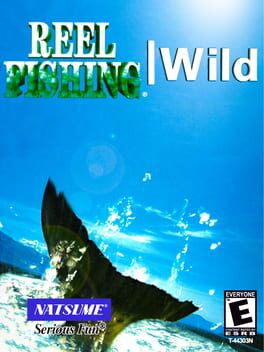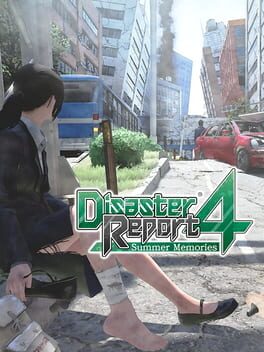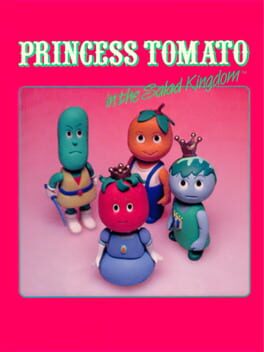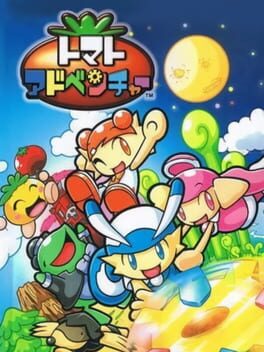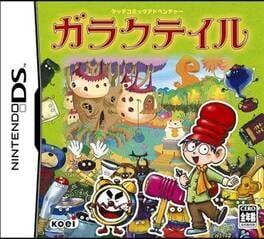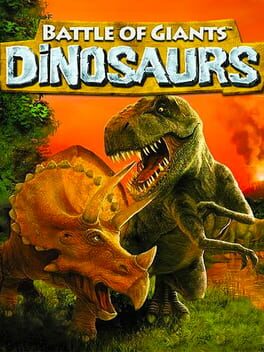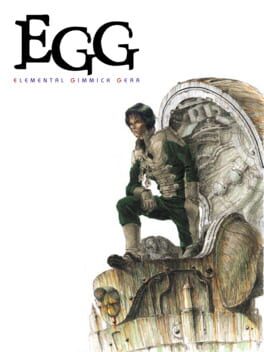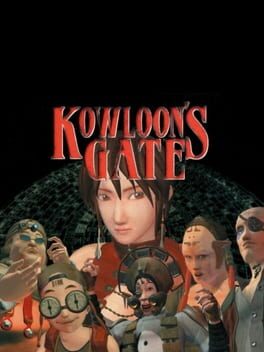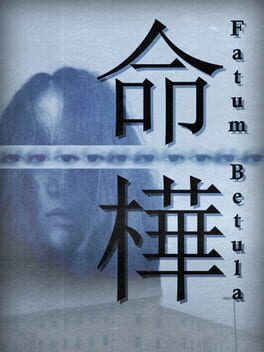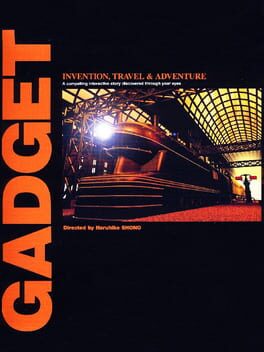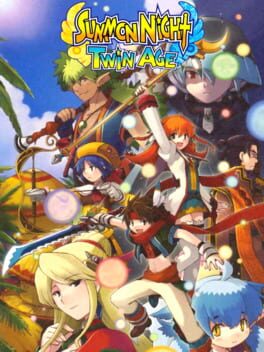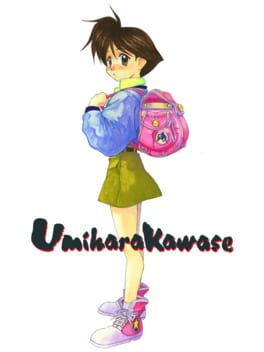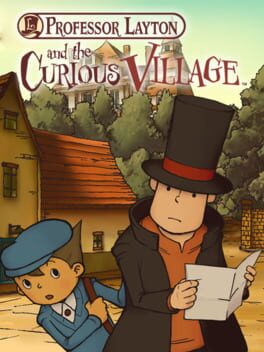DizzySkullKid19
2001
Filler review, this time dropping a really interesting fact. Apparently, and you can fact check me on this, this game was scored by T's Music, who also worked on the score of frickin' OKAMI.
Now that's pretty cool, and it explains a lot of the epic sounds of this game.
I love the Reel Fishing series too, really relaxing fishing games, and this is probably the most relaxing on the dreamcast. I think comparing it to things like Sega Bass Fishing and the like is comparing apples to oranges, so I don't like how this is often put in competition with those games.
Kind of sad that they got rid of the aquarium, but I understand why, maybe for space limitations.
Now that's pretty cool, and it explains a lot of the epic sounds of this game.
I love the Reel Fishing series too, really relaxing fishing games, and this is probably the most relaxing on the dreamcast. I think comparing it to things like Sega Bass Fishing and the like is comparing apples to oranges, so I don't like how this is often put in competition with those games.
Kind of sad that they got rid of the aquarium, but I understand why, maybe for space limitations.
This may be a bold choice - but I want to say something about Disaster Report 4 before I'm even done with it.
This games genius comes from how it tries to portray something that, in my opinion, video game medium or perhaps I should say industry struggles to come to terms with - "social realism", an earnest portrayal of the actual conditions of suffering in a society.
Now, it may seem strange to declare Disaster Report 4 a depiction of a society, when it at surface value is a depiction of natural disaster and it's effects on a society. Yet, I see something even deeper here.
I'm sure a lot of us have endured natural disasters of some sort. For me, living on the coastline of America, said natural disasters were often hurricanes. At first, when I was doing some volunteering to help mitigate the impacts of such a disaster, I had the true idea that "it brought out the good in people". Only, at that time this idea was somewhat superficial.
Since, I found in this game that disasters not only bring about good faith in each other as human beings, but also show and X-ray of a society that causes people suffering. Here we can see people with their heads down, suffering from not only natural disasters but the kind of bureaucratic cushioning that tries to absorb the impact of the natural disasters, while human individuals are left in the dark. Take an example of a character in this game, a man from a poor family who moved to the city after getting a job offering, who made it through multiple stages of the interview process before the disaster hit. All of a sudden his suffering is at a boiling point - not only has he come to the city searching for a job so he can support his family, but that hope has ultimately collapsed and as a result left him collapsed. In the search for light and hope for his family, and in his total destitution and misery at his own perceived failure to do so, do we realize something - no corporate body will set him free from this, it's *ultimately the power of human love at it's simplest, love for the Other (A la Levinas's Ethics https://en.wikipedia.org/wiki/Other_(philosophy) ) - that we come to understand how interdependent we are.
So the thesis that natural disasters "bring out the good in people" is not totally unfalse -
but we have to see the profundity of this good, that it's a good that has to happen through struggling in order to be 'pure good'.
There are multiple people in this game who's life situations are ultimately at maybe their bleakest, and this is ultimately where the 'social realism' of this game shines through.
This is amazing, because I think the game medium itself encourages a kind of detachment from our own bodies - an 'out-of-body' experience, our movement projected onto an avatar. In order to make gaming 'pleasant' many video game companies resort to thus providing fantastical worlds, these days, most likely "open" worlds where peoples desire for escape from the vicissitudes of everyday life is ultimately encouraged, as a trade off for their money. So the fact that a game like Disaster Report 4 is allowed to exist is amazing. You won't find much extremely pleasant in gameplay here, for good and bad reasons - one such reason is that you are dodging natural disasters, collapsing buildings. For those of us who have survived this thing - it is an unpleasant thought to see our very human avatar being killed by a falling steel building.
I'm sure Granzella themselves were very aware of this - they were planning to release the game a day before the 2011 Tohoku Earthquake hit (source: https://www.vgfacts.com/game/disasterreport4summermemories/), that caused at least 18,000 people to die (source: https://www.ncei.noaa.gov/news/day-2011-japan-earthquake-and-tsunami).
So knowing this, I think Granzella (who before the earthquake was known as Irem) must've known that the Disaster Report series could not stick to it's roots as simply a fictional disaster-flick inspired game (not to say the original games were without any weight, either though). Many people who had survived the disaster who would think to play this game would find such a representation bullshit at best, and insensitive at worst. Yet, in a stroke I consider genius, they had to imbue it with a serious humanistic weight. It's one of the most 'real' games that I've played all my life.
Play this, it should hit you like a lightning bolt.
This games genius comes from how it tries to portray something that, in my opinion, video game medium or perhaps I should say industry struggles to come to terms with - "social realism", an earnest portrayal of the actual conditions of suffering in a society.
Now, it may seem strange to declare Disaster Report 4 a depiction of a society, when it at surface value is a depiction of natural disaster and it's effects on a society. Yet, I see something even deeper here.
I'm sure a lot of us have endured natural disasters of some sort. For me, living on the coastline of America, said natural disasters were often hurricanes. At first, when I was doing some volunteering to help mitigate the impacts of such a disaster, I had the true idea that "it brought out the good in people". Only, at that time this idea was somewhat superficial.
Since, I found in this game that disasters not only bring about good faith in each other as human beings, but also show and X-ray of a society that causes people suffering. Here we can see people with their heads down, suffering from not only natural disasters but the kind of bureaucratic cushioning that tries to absorb the impact of the natural disasters, while human individuals are left in the dark. Take an example of a character in this game, a man from a poor family who moved to the city after getting a job offering, who made it through multiple stages of the interview process before the disaster hit. All of a sudden his suffering is at a boiling point - not only has he come to the city searching for a job so he can support his family, but that hope has ultimately collapsed and as a result left him collapsed. In the search for light and hope for his family, and in his total destitution and misery at his own perceived failure to do so, do we realize something - no corporate body will set him free from this, it's *ultimately the power of human love at it's simplest, love for the Other (A la Levinas's Ethics https://en.wikipedia.org/wiki/Other_(philosophy) ) - that we come to understand how interdependent we are.
So the thesis that natural disasters "bring out the good in people" is not totally unfalse -
but we have to see the profundity of this good, that it's a good that has to happen through struggling in order to be 'pure good'.
There are multiple people in this game who's life situations are ultimately at maybe their bleakest, and this is ultimately where the 'social realism' of this game shines through.
This is amazing, because I think the game medium itself encourages a kind of detachment from our own bodies - an 'out-of-body' experience, our movement projected onto an avatar. In order to make gaming 'pleasant' many video game companies resort to thus providing fantastical worlds, these days, most likely "open" worlds where peoples desire for escape from the vicissitudes of everyday life is ultimately encouraged, as a trade off for their money. So the fact that a game like Disaster Report 4 is allowed to exist is amazing. You won't find much extremely pleasant in gameplay here, for good and bad reasons - one such reason is that you are dodging natural disasters, collapsing buildings. For those of us who have survived this thing - it is an unpleasant thought to see our very human avatar being killed by a falling steel building.
I'm sure Granzella themselves were very aware of this - they were planning to release the game a day before the 2011 Tohoku Earthquake hit (source: https://www.vgfacts.com/game/disasterreport4summermemories/), that caused at least 18,000 people to die (source: https://www.ncei.noaa.gov/news/day-2011-japan-earthquake-and-tsunami).
So knowing this, I think Granzella (who before the earthquake was known as Irem) must've known that the Disaster Report series could not stick to it's roots as simply a fictional disaster-flick inspired game (not to say the original games were without any weight, either though). Many people who had survived the disaster who would think to play this game would find such a representation bullshit at best, and insensitive at worst. Yet, in a stroke I consider genius, they had to imbue it with a serious humanistic weight. It's one of the most 'real' games that I've played all my life.
Play this, it should hit you like a lightning bolt.
(This game was too hard to rate, but if I did it would be 2.75 stars, just below 3 stars.)
Incredibly charming, but incredibly outmoded adventure game that's kind of hard to recommend without a guide.
Well, I'm not sure I've been starting 2024 off on a great foot game-wise, because I've shelved more games then I've actually completed, and for some reason I feel a kind of shame about it. I also want to say sorry to Hudson because my previous attempt with one of their games (Elemental Gimmick Gear) resulted in a similar shelving rather than completing due to mechanical issues within the game itself, although the atmosphere was breathtaking.
While I might not describe Princess Tomato's atmosphere as breathtaking, it did have a sort of quaint almost dreamy feel to it. Even the cover art, where the characters seem to be made of clay has an incredibly vintage feel to it, vegetable and fruit characters in semi-medievalist, fairy tale attire is an oddly comforting kind of surrealism.
Princess Tomato is one where I don't really know what went wrong - because you can say that a lot of it's gameplay is just bound up in the tropes of the early adventure games, part and parcel of a game around its era. The puzzles are just barely solvable without a guide, but I highly recommend using one anyway at parts.
So where do I put the blame? Frankly, I don't know. There was just something tiring here. If Princess Tomato is vintage, it's vintage, but with a slight musty smell. Some might like the smell of an old book for example, maybe because it "brings them back" (but not always). Anyway, I bring that up because I think for people who are nostalgic for this time of gaming and old text adventures (A la Portopia Serial Murder Case and maybe Shadowgate) the jank is almost a part of the fun nostalgic trip. It's a "you had to be there thing", that I think this game kind of suffers from.
To follow the less than perfect metaphor, the smell of an old book might be off putting, especially if one can tell it's pages are filled with labyrinth prose, winding plot threads and such. Not that Princess Tomato is at all a dense tome, but it does have a sense of confusion and you will be lost. There's a painful maze section, it drops you into combat with kind of no explanation on how to actually fight (you do it through rock paper scissors and then a guessing game, it's hard to explain). Then there is the insane amount of menu options: LOOK, CHECK (why aren't look and check the same thing?), FIGHT, PUNCH, etc. that makes me appreciate the sleek interfaces of the modern point-and-clicks.
Yet, like I said, it's quaint, humorous and has some banging chiptune. It's kind of a pick-your-poison with this and equally old text adventures (not that they are all abstrusely designed), where you have to kind of make a trade-off between charm and ease of play. If you have nostalgia for this kind of thing, this might not even faze you. I'm not sure how this game would even translate into a remake, though it would help to modernize it a bit at least graphics wise, although the graphics are charming in an 8-bit interface and look good on the NES (and according to Hardcore Gaming 101 it did get a remake for Japanese mobile phones).
Finally, believe it or not I actually played this game on my dreamcast, using an emulator, so the fact that I had to wait for my boot disc to load, after about 15 tries each time, didn't help with making me want to play it. I'll definitely give it another go... with a different setup.
Incredibly charming, but incredibly outmoded adventure game that's kind of hard to recommend without a guide.
Well, I'm not sure I've been starting 2024 off on a great foot game-wise, because I've shelved more games then I've actually completed, and for some reason I feel a kind of shame about it. I also want to say sorry to Hudson because my previous attempt with one of their games (Elemental Gimmick Gear) resulted in a similar shelving rather than completing due to mechanical issues within the game itself, although the atmosphere was breathtaking.
While I might not describe Princess Tomato's atmosphere as breathtaking, it did have a sort of quaint almost dreamy feel to it. Even the cover art, where the characters seem to be made of clay has an incredibly vintage feel to it, vegetable and fruit characters in semi-medievalist, fairy tale attire is an oddly comforting kind of surrealism.
Princess Tomato is one where I don't really know what went wrong - because you can say that a lot of it's gameplay is just bound up in the tropes of the early adventure games, part and parcel of a game around its era. The puzzles are just barely solvable without a guide, but I highly recommend using one anyway at parts.
So where do I put the blame? Frankly, I don't know. There was just something tiring here. If Princess Tomato is vintage, it's vintage, but with a slight musty smell. Some might like the smell of an old book for example, maybe because it "brings them back" (but not always). Anyway, I bring that up because I think for people who are nostalgic for this time of gaming and old text adventures (A la Portopia Serial Murder Case and maybe Shadowgate) the jank is almost a part of the fun nostalgic trip. It's a "you had to be there thing", that I think this game kind of suffers from.
To follow the less than perfect metaphor, the smell of an old book might be off putting, especially if one can tell it's pages are filled with labyrinth prose, winding plot threads and such. Not that Princess Tomato is at all a dense tome, but it does have a sense of confusion and you will be lost. There's a painful maze section, it drops you into combat with kind of no explanation on how to actually fight (you do it through rock paper scissors and then a guessing game, it's hard to explain). Then there is the insane amount of menu options: LOOK, CHECK (why aren't look and check the same thing?), FIGHT, PUNCH, etc. that makes me appreciate the sleek interfaces of the modern point-and-clicks.
Yet, like I said, it's quaint, humorous and has some banging chiptune. It's kind of a pick-your-poison with this and equally old text adventures (not that they are all abstrusely designed), where you have to kind of make a trade-off between charm and ease of play. If you have nostalgia for this kind of thing, this might not even faze you. I'm not sure how this game would even translate into a remake, though it would help to modernize it a bit at least graphics wise, although the graphics are charming in an 8-bit interface and look good on the NES (and according to Hardcore Gaming 101 it did get a remake for Japanese mobile phones).
Finally, believe it or not I actually played this game on my dreamcast, using an emulator, so the fact that I had to wait for my boot disc to load, after about 15 tries each time, didn't help with making me want to play it. I'll definitely give it another go... with a different setup.
2002
This game is magic, but it's kind of like a magic show that goes on for too long, where you want the magician to stop and let your parents take you home.
AlphaDream's pre-Mario & Luigi outing is somehow even zanier than a lot of things in that series.
(I'll get this out of the way too, the final dungeon goes on for waaay too long.)
However, this feels like unfiltered creative energy, while Superstar Saga feels like it's more filtered, polished and focused creative energy. Like water put through a sieve and partially de-mineralized, thus more digestible.
As a result, the game can fly too close to the sun with regards to how nonsensical and unapologetically left-field it is - and it often wears thin later on in the game. It felt like they were a desperate street magician always pulling thousand of tricks out of their hat in order to get passerby's attention. Impressive, but ultimately 'clingy' if that makes sense as an adjective for a game.
The story is interesting but majorly confusing - and not that it has to be the most well written for a JRPG intended to be excessively lighthearted. Still, I came out of this at the end kind of bone-weary of all the jokes, and really, really wishing for some of the plot points to be explained or even a dredge of character development. Characters like Rellek and Sofubi (names in the wonderful English translation) don't really have that much depth to begin with, or motivations other than "this journey sounds cool, I'll join you now K?"
The battle system is not all fun and games either. You basically attack only with techniques called Gimmicks, and you get more Gimmicks as you progress through one way or another (there are multiple ways to attain them). All of the Gimmicks require you to do a kind of Warioware-esque microgame in order for them to have much power.
Yet, I just really wasn't a huge fan of this system. Imagine a Mario & Luigi game where you can only use Bros Attacks. Then add that there are like (at least) 35 different Bros Attacks to choose from and ones for each character + you have multiple party members to juggle. I don't think this is the most optimized or polished RPG system, not by a long shot.
Yet, despite all these faults, it's a three star game because it's quite amazing, for AlphaDream's "first" attempt at this kind of thing. Yes, they had another amazing debut game for the Game Boy Color, "Koto Battle", but I'd say this is the first game of theirs in this kind of extremely zany style. I wonder how they managed to imbue this game with the kind of stylistic organization that would become a hallmark of all their later games (until the companies sad alleged going-away recently)? It's undoubtedly wondrous. It's really hard to describe, and you can only understand by playing it. The bouncy music, the feeling that I'm in the imaginings of a strange and unique child (like I was). Whimsical, almost mad genius-like (like I wasn't). Daydreaming their own strange fairy tale based on the ones they hear in school.
It's not without cliche though, and it actually has a lot of those damsel-in-distress plot points, but overall for it's stylistics alone it's bumped up half a star from what it would be.
Overall, I'd recommend you play this after you experience at least a few of the Mario & Luigi games - for then you will appreciate how far AlphaDream had come since this release, and you'll also see a lot of the lineage of those games here.
It's ultimately a pretty imperfect and sometimes annoying game - but endlessly charming, surprising and enjoyable. If the PS1 game "moon", as the story goes, was a deconstruction of RPG's from without, this game is a deconstruction from within and using RPG mechanics. It's about as flawed as something attempting that can be - yet it's worth taking a look at, even a brief one, for seeing an attempt at that sort of thing, a really colorful attempt.
(My play time upon completing the game was about 14 hours 53 minutes)
AlphaDream's pre-Mario & Luigi outing is somehow even zanier than a lot of things in that series.
(I'll get this out of the way too, the final dungeon goes on for waaay too long.)
However, this feels like unfiltered creative energy, while Superstar Saga feels like it's more filtered, polished and focused creative energy. Like water put through a sieve and partially de-mineralized, thus more digestible.
As a result, the game can fly too close to the sun with regards to how nonsensical and unapologetically left-field it is - and it often wears thin later on in the game. It felt like they were a desperate street magician always pulling thousand of tricks out of their hat in order to get passerby's attention. Impressive, but ultimately 'clingy' if that makes sense as an adjective for a game.
The story is interesting but majorly confusing - and not that it has to be the most well written for a JRPG intended to be excessively lighthearted. Still, I came out of this at the end kind of bone-weary of all the jokes, and really, really wishing for some of the plot points to be explained or even a dredge of character development. Characters like Rellek and Sofubi (names in the wonderful English translation) don't really have that much depth to begin with, or motivations other than "this journey sounds cool, I'll join you now K?"
The battle system is not all fun and games either. You basically attack only with techniques called Gimmicks, and you get more Gimmicks as you progress through one way or another (there are multiple ways to attain them). All of the Gimmicks require you to do a kind of Warioware-esque microgame in order for them to have much power.
Yet, I just really wasn't a huge fan of this system. Imagine a Mario & Luigi game where you can only use Bros Attacks. Then add that there are like (at least) 35 different Bros Attacks to choose from and ones for each character + you have multiple party members to juggle. I don't think this is the most optimized or polished RPG system, not by a long shot.
Yet, despite all these faults, it's a three star game because it's quite amazing, for AlphaDream's "first" attempt at this kind of thing. Yes, they had another amazing debut game for the Game Boy Color, "Koto Battle", but I'd say this is the first game of theirs in this kind of extremely zany style. I wonder how they managed to imbue this game with the kind of stylistic organization that would become a hallmark of all their later games (until the companies sad alleged going-away recently)? It's undoubtedly wondrous. It's really hard to describe, and you can only understand by playing it. The bouncy music, the feeling that I'm in the imaginings of a strange and unique child (like I was). Whimsical, almost mad genius-like (like I wasn't). Daydreaming their own strange fairy tale based on the ones they hear in school.
It's not without cliche though, and it actually has a lot of those damsel-in-distress plot points, but overall for it's stylistics alone it's bumped up half a star from what it would be.
Overall, I'd recommend you play this after you experience at least a few of the Mario & Luigi games - for then you will appreciate how far AlphaDream had come since this release, and you'll also see a lot of the lineage of those games here.
It's ultimately a pretty imperfect and sometimes annoying game - but endlessly charming, surprising and enjoyable. If the PS1 game "moon", as the story goes, was a deconstruction of RPG's from without, this game is a deconstruction from within and using RPG mechanics. It's about as flawed as something attempting that can be - yet it's worth taking a look at, even a brief one, for seeing an attempt at that sort of thing, a really colorful attempt.
(My play time upon completing the game was about 14 hours 53 minutes)
2006
https://peopleoftheboneblog.blogspot.com/2024/01/garaku-tale-chapter-1-2-flawed.html
Published my flawed translation (from consulting my Japanese speaking sibling and using translators) as well as my guide for the first two chapters. Hope it's understandable, please ask questions if it's not.
Published my flawed translation (from consulting my Japanese speaking sibling and using translators) as well as my guide for the first two chapters. Hope it's understandable, please ask questions if it's not.
Dreamcast Marathon -
E.G.G. should be a miracle: a 2D Zelda-like on the Dreamcast with almost impeccable atmospherics is a rare treat on a console packed with, for lack of a better term, more brawny than brainy experiences; I think of games like Crazy Taxi and batsh*t fighters and beat-em ups in the Power Stone and Dynamite Cop category, or breakneck fast 3D platformers in the Sonic Adventure category.
Not that the aforementioned games don't require any strategy or thinking, but they are almost tiring in their hyperactive insistence on frantic showcases of (at-the-time) pyrotechnic visual wizardry. I never thought of the Dreamcast as a inherently 'relaxing' console, not even as one for relaxing action games. Not that it's particularly starved for such a thing (Shenmue, for example) but it doesn't exactly shine in this category of games.
E.G.G. fulfilled that specific niche for me as a Zelda-lover and a Dreamcast owner, as well as relaxing game enjoyer. If I were rating it on vibes alone, it would be 4 stars, easy. However, the gameplay is quite tiring - and not easily overlookable. For one, the combat is very clunky.
The knockback from enemies is extraordinarily irksome. For some of the enemies move extremely fast, to where it's impossible to get a good vantage point to hit them; and really, they are more likely to hit you (even if you sneak up to them) with how fast their response is. This means your HP can drain from like 200 to 0 really fast, and I'm not kidding.
Also, there is really only a few dungeons in this game, and only 1 main one named Fogna. This is pretty cool in concept, but I'll be danged if it doesn't lead to some ultimately painful backtracking. I would have enjoyed more interesting variety in the setting, even just artistically. Although it is stunningly beautiful, it wears thin, because the games setting never really varies that much. The areas seemed to blend into each other a little too much. We have weird little desert/shrubbery areas, and some mechanical sci-fi areas, but not much more.
By far my least favorite part was how is every time you select to continue - it doesn't start you off at the HP you were at on the room before, but bumps it down to not even half of your full HP. So you can die at a boss, select continue and well, too bad, you're back at like 55 out of 200 HP.
There is a lot of positives to this one - but I'm going to shelve it and give it another chance. It's biggest merit is it's spectacular art style and music - and being a unique game for this system. However, it took a lot of patience, at least for me.
(My total play time was about 5 hours 40 minutes)
E.G.G. should be a miracle: a 2D Zelda-like on the Dreamcast with almost impeccable atmospherics is a rare treat on a console packed with, for lack of a better term, more brawny than brainy experiences; I think of games like Crazy Taxi and batsh*t fighters and beat-em ups in the Power Stone and Dynamite Cop category, or breakneck fast 3D platformers in the Sonic Adventure category.
Not that the aforementioned games don't require any strategy or thinking, but they are almost tiring in their hyperactive insistence on frantic showcases of (at-the-time) pyrotechnic visual wizardry. I never thought of the Dreamcast as a inherently 'relaxing' console, not even as one for relaxing action games. Not that it's particularly starved for such a thing (Shenmue, for example) but it doesn't exactly shine in this category of games.
E.G.G. fulfilled that specific niche for me as a Zelda-lover and a Dreamcast owner, as well as relaxing game enjoyer. If I were rating it on vibes alone, it would be 4 stars, easy. However, the gameplay is quite tiring - and not easily overlookable. For one, the combat is very clunky.
The knockback from enemies is extraordinarily irksome. For some of the enemies move extremely fast, to where it's impossible to get a good vantage point to hit them; and really, they are more likely to hit you (even if you sneak up to them) with how fast their response is. This means your HP can drain from like 200 to 0 really fast, and I'm not kidding.
Also, there is really only a few dungeons in this game, and only 1 main one named Fogna. This is pretty cool in concept, but I'll be danged if it doesn't lead to some ultimately painful backtracking. I would have enjoyed more interesting variety in the setting, even just artistically. Although it is stunningly beautiful, it wears thin, because the games setting never really varies that much. The areas seemed to blend into each other a little too much. We have weird little desert/shrubbery areas, and some mechanical sci-fi areas, but not much more.
By far my least favorite part was how is every time you select to continue - it doesn't start you off at the HP you were at on the room before, but bumps it down to not even half of your full HP. So you can die at a boss, select continue and well, too bad, you're back at like 55 out of 200 HP.
There is a lot of positives to this one - but I'm going to shelve it and give it another chance. It's biggest merit is it's spectacular art style and music - and being a unique game for this system. However, it took a lot of patience, at least for me.
(My total play time was about 5 hours 40 minutes)
1997
Kowloon's Gate was sadly a little too dense for me. Not in the other senses of that word, but of layered and ornate. Overwhelmingly so for me -
For this is a game that boasts a cornucopia of influences - weird philosophy and psychology guys like Deleuze and Guattari, Carl Jung and the like; Not to mention steampunk, cyberpunk and according to this article (http://www.hardcoregaming101.net/kowloons-gate/) gothic architectural concepts. They wanted to create a whole new concept of "Asia Gothic" - very few games that I can think of have the ambition of creating a whole new aesthetic paradigm.
The game elaborates on the idea from Chinese spirituality - "Feng Shui". Of course, we might have the bastardized idea of Feng Shui which makes it simply a matter of modern interior design. Feng Shui is kind of about design - but not simply of furniture, and not simply about peaceful modern living. It's about arrangements on the Earth in general, and applied to Kowloon Walled City - finding meaning in dark and claustrophobic spaces full of suffering.
A game that tries to tackle the 'mystique' of this historical community, and does it in fantastical terms, seems to me pretty rare. The Kowloon Walled City of this game is a place where dark, sunless places are where everything is possible - not just in the optimistic sense, but in the sense of going beyond what is 'natural'.
It's a double-edged sword - Kowloon Walled City presented through this games wonders that a neon-lit, uncomfortably compact and self-contained city can nonetheless be deeply connected to some kind of possibility for our lives. What can a cramped room teach us, what is the poetry there? Even if it's that we float towards the sunlight, like shrimp. Yet it's far from romantic about these ideas - and this is the other side of it. It presents the problematic of Kowloon in a way I've never seen before. Nuanced, and only because it presents things in a fantastical lens.
Reading up on Feng Shui, and how it was intertwined with the architecture of the family unit (source: https://en.wikipedia.org/wiki/Feng_shui, under "expression of identity) and being used to analyze dualisms; I can also see the political side of it.
I'm grateful, because there is a translation team working on this game, and I've heard they are pretty much done with the translation part.
It's gonna be awesome.
For this is a game that boasts a cornucopia of influences - weird philosophy and psychology guys like Deleuze and Guattari, Carl Jung and the like; Not to mention steampunk, cyberpunk and according to this article (http://www.hardcoregaming101.net/kowloons-gate/) gothic architectural concepts. They wanted to create a whole new concept of "Asia Gothic" - very few games that I can think of have the ambition of creating a whole new aesthetic paradigm.
The game elaborates on the idea from Chinese spirituality - "Feng Shui". Of course, we might have the bastardized idea of Feng Shui which makes it simply a matter of modern interior design. Feng Shui is kind of about design - but not simply of furniture, and not simply about peaceful modern living. It's about arrangements on the Earth in general, and applied to Kowloon Walled City - finding meaning in dark and claustrophobic spaces full of suffering.
A game that tries to tackle the 'mystique' of this historical community, and does it in fantastical terms, seems to me pretty rare. The Kowloon Walled City of this game is a place where dark, sunless places are where everything is possible - not just in the optimistic sense, but in the sense of going beyond what is 'natural'.
It's a double-edged sword - Kowloon Walled City presented through this games wonders that a neon-lit, uncomfortably compact and self-contained city can nonetheless be deeply connected to some kind of possibility for our lives. What can a cramped room teach us, what is the poetry there? Even if it's that we float towards the sunlight, like shrimp. Yet it's far from romantic about these ideas - and this is the other side of it. It presents the problematic of Kowloon in a way I've never seen before. Nuanced, and only because it presents things in a fantastical lens.
Reading up on Feng Shui, and how it was intertwined with the architecture of the family unit (source: https://en.wikipedia.org/wiki/Feng_shui, under "expression of identity) and being used to analyze dualisms; I can also see the political side of it.
I'm grateful, because there is a translation team working on this game, and I've heard they are pretty much done with the translation part.
It's gonna be awesome.
2020
Pretty deeply mystical adventure/exploration game.
Dare I say it's somewhat minimalist - it doesn't rely on a huge map, an extreme amount of characters, or even being a very long game. It does however, have multiple endings and quite a few secrets.
It's low-poly PS1 style managed to be just the right niche for me, and I imagine many others. It has a very charming graphical style, which while trying to mimic the PS1 look, ends up giving it a unique sheen all of it's own.
Not unlike many adventure games, it has plenty of "how the heck was I supposed to know how to do that?" moments.
Ultimately though, it's a very deeply meditative and somber game. Despite some cute character designs, it's far from light. The ultimate tone it produces is one of serenity and acceptance, however.
Dare I say it's somewhat minimalist - it doesn't rely on a huge map, an extreme amount of characters, or even being a very long game. It does however, have multiple endings and quite a few secrets.
It's low-poly PS1 style managed to be just the right niche for me, and I imagine many others. It has a very charming graphical style, which while trying to mimic the PS1 look, ends up giving it a unique sheen all of it's own.
Not unlike many adventure games, it has plenty of "how the heck was I supposed to know how to do that?" moments.
Ultimately though, it's a very deeply meditative and somber game. Despite some cute character designs, it's far from light. The ultimate tone it produces is one of serenity and acceptance, however.
Absolutely insane game for 1993 - it's no exaggeration that this inspired many well known filmmakers, hell, a sizeable portion of modern sci-fi cinema in general.
It's a game that can be completed in a single afternoon, but this doesn't lessen it's power.
The CG, prerendered 3d spaces, are all just of mind-blowing beauty. This must have absolutely shocked people back then.
The music, while minimal, creates such an atmosphere of impeding dread and doom. The train is like a percussion instrument, setting the beat for a song of death.
It's effortlessly cinematic. I can see how a lot of those late 90's early 2000's, "trippy" sci-fi flicks were inspired by this (a la the Matrix).
It's interesting: the developers, Synergy, are not really what I would consider to be high profile. At least not in the West. They've made waves before, but with only one other game: "Alice: an Interactive Museum".
They've made some incredibly strange games over the years, such as a a series of Wizard of Oz RPGs (not the one for the DS). Those were this developers final games, IIRC.
It surprises me, because this game just feels like a switch went off in the developers mind, and they decided they were going to knock it out of the park. Not that this developers other games are bad in any respect, in fact I'd say they are all hidden diamonds; just that this game feels like such a culmination of energy and themes that they've worked on in other games. Large, art deco institutions. A weird steampunk/cyberpunk mix with themes of: alienation, the viewing of technology as salvation, and the meaning of huge, kaleidoscopic temples of steel. Haruhiko Shono, and his team are genius for this.
It's a game that can be completed in a single afternoon, but this doesn't lessen it's power.
The CG, prerendered 3d spaces, are all just of mind-blowing beauty. This must have absolutely shocked people back then.
The music, while minimal, creates such an atmosphere of impeding dread and doom. The train is like a percussion instrument, setting the beat for a song of death.
It's effortlessly cinematic. I can see how a lot of those late 90's early 2000's, "trippy" sci-fi flicks were inspired by this (a la the Matrix).
It's interesting: the developers, Synergy, are not really what I would consider to be high profile. At least not in the West. They've made waves before, but with only one other game: "Alice: an Interactive Museum".
They've made some incredibly strange games over the years, such as a a series of Wizard of Oz RPGs (not the one for the DS). Those were this developers final games, IIRC.
It surprises me, because this game just feels like a switch went off in the developers mind, and they decided they were going to knock it out of the park. Not that this developers other games are bad in any respect, in fact I'd say they are all hidden diamonds; just that this game feels like such a culmination of energy and themes that they've worked on in other games. Large, art deco institutions. A weird steampunk/cyberpunk mix with themes of: alienation, the viewing of technology as salvation, and the meaning of huge, kaleidoscopic temples of steel. Haruhiko Shono, and his team are genius for this.
The semester is out for break.
I've been pretty much locked in my room the past few days. The reason: I've been so sucked up in this game. This is truly an awesome action rpg slash dungeon crawler for the DS, and it might have just become one of my favorite gems for the system. With a surprisingly heavy story, that deals with real world issues (albeit in a fantasy world setting), and the wonderfully woven and intricate progression system, I think this one is a keeper!
It starts out with enough naivete. A brother and his loving sister, or a sister and his loving brother, notice something is wrong in their hometown. The spirits are out of wack. So they go on an investigation across the land - yet, I wasn't prepared for how dark the story got.
It truly surprised me, it goes a lot into the ugly issues of this fantasy world, a place where most JRPG'S would dare to go. Indeed, I would say it actually does tackle some pretty heavy themes of discrimination and racism, between the two main factions of the game. I don't know if it was trying to tackle these very real issues intentionally, but it did really affect me. I don't bring this up lightly, that is to say.
This takes place in a literally animist society, that is, where spirits are everywhere and control the balance of the world. That plot point isn't too unexpected from a JRPG. However, here's where it diverges: there are two main factions in the game, the humans and the Kazcusca and they have been at war. The humans have essentially been putting in factories many spirits in order to fuel their... infrastructure or something, and they also experiment on Kazcusca.
We start out thinking the humans are uncomplicated evil, since they have been enslaving the spirits and using them to power their civilization. However, as the game goes on, they ultimately show a sympathetic side. They had been duped. I loved how it had that aspect of being caught up in a complicated, grey area. I genuinely cared to see where the story went next, and there wasn't a second where I felt the plot wasn't developing in an very absorbing way.
The mechanics are just light enough, but they feel like a genuine article JRPG. I was at first shaking in my boots to hear the terms "skill tree", "crafting", "summoning" and the like; however, this game makes all these aspects feasible and digestible. I must say thanks to it for this.
Since, for the around 11 hours it took me to beat this game, I never felt overwhelmed. I will admit, the battle system did get a tiny bit repetitive at times, and the difficulty spikes were a little jarring. It's far from perfectly balanced. Yet, why can't I help but love it? For one the digestible and friendly mechanics lighten the load quite a bit, there isn't a single moment in this game that I would say is unbeatable even for a first time player. However...
------------------THE BOTTOM LINE-----------------------
It's really the story that sold me on this. It actually has the power I've been missing from a lot of JRPG narratives. It tackles it's issues in very mature, real world terms. I was once holed up in another room, from sickness (I won't disclose the details) - and during that time I missed videogames, and had envisioned a JRPG similar in plot to this one. I didn't want escapism, but I didn't want harsh realism either. A kind of soulful reimagining, reframing of real world issues, that while far from solving them or even being a properly nuanced handling of them, gave me hope.
This game gave me hope. It reminded me of that envisioning. The divisions of this games society and the very human nature of the characters. It was so simple, but it just hit so hard.
I've been pretty much locked in my room the past few days. The reason: I've been so sucked up in this game. This is truly an awesome action rpg slash dungeon crawler for the DS, and it might have just become one of my favorite gems for the system. With a surprisingly heavy story, that deals with real world issues (albeit in a fantasy world setting), and the wonderfully woven and intricate progression system, I think this one is a keeper!
It starts out with enough naivete. A brother and his loving sister, or a sister and his loving brother, notice something is wrong in their hometown. The spirits are out of wack. So they go on an investigation across the land - yet, I wasn't prepared for how dark the story got.
It truly surprised me, it goes a lot into the ugly issues of this fantasy world, a place where most JRPG'S would dare to go. Indeed, I would say it actually does tackle some pretty heavy themes of discrimination and racism, between the two main factions of the game. I don't know if it was trying to tackle these very real issues intentionally, but it did really affect me. I don't bring this up lightly, that is to say.
This takes place in a literally animist society, that is, where spirits are everywhere and control the balance of the world. That plot point isn't too unexpected from a JRPG. However, here's where it diverges: there are two main factions in the game, the humans and the Kazcusca and they have been at war. The humans have essentially been putting in factories many spirits in order to fuel their... infrastructure or something, and they also experiment on Kazcusca.
We start out thinking the humans are uncomplicated evil, since they have been enslaving the spirits and using them to power their civilization. However, as the game goes on, they ultimately show a sympathetic side. They had been duped. I loved how it had that aspect of being caught up in a complicated, grey area. I genuinely cared to see where the story went next, and there wasn't a second where I felt the plot wasn't developing in an very absorbing way.
The mechanics are just light enough, but they feel like a genuine article JRPG. I was at first shaking in my boots to hear the terms "skill tree", "crafting", "summoning" and the like; however, this game makes all these aspects feasible and digestible. I must say thanks to it for this.
Since, for the around 11 hours it took me to beat this game, I never felt overwhelmed. I will admit, the battle system did get a tiny bit repetitive at times, and the difficulty spikes were a little jarring. It's far from perfectly balanced. Yet, why can't I help but love it? For one the digestible and friendly mechanics lighten the load quite a bit, there isn't a single moment in this game that I would say is unbeatable even for a first time player. However...
------------------THE BOTTOM LINE-----------------------
It's really the story that sold me on this. It actually has the power I've been missing from a lot of JRPG narratives. It tackles it's issues in very mature, real world terms. I was once holed up in another room, from sickness (I won't disclose the details) - and during that time I missed videogames, and had envisioned a JRPG similar in plot to this one. I didn't want escapism, but I didn't want harsh realism either. A kind of soulful reimagining, reframing of real world issues, that while far from solving them or even being a properly nuanced handling of them, gave me hope.
This game gave me hope. It reminded me of that envisioning. The divisions of this games society and the very human nature of the characters. It was so simple, but it just hit so hard.
This is a fun kind of turn-your-brain-off game, with surprisingly great music. Don't be fooled by the somewhat gruff title "REEL FISHING" - this is anything but a fast and macho arcade-y fishing game. I played it last year, and it convinced me to enjoy fishing games. It has pretty music, pretty pre-rendered backgrounds of various lakes and rivers (as well as bodies of water from around the world), and an aquarium where you can put the fish you caught. Plus, there's also various different accessories for your tank, such as miniature models of landmarks around the world.
The fishing mechanic is the same that most fishing games use (Sega Fishing series, Fishing Resort, etc.) where you have a meter that goes up or down depending on how fast you reel in. If the meter goes into the red - that means to back off for a little bit because the line is about to snap. However, beware, you can't let it to go too far into the blue from not reeling in, because then the fish will be let off the hook. Looking back on it, I can't remember if the meter is actually visible, so you might have to rely on the sound the line makes.
It's a very simple but fun premise, and it gets pretty intense, Sega Bass/Marine fishing levels of intense.
Overall, it's an extremely simple game, but an oddly relaxing experience. There is really nothing to it, but it has an odd kind of serenity that has attracted me to this series.
The fishing mechanic is the same that most fishing games use (Sega Fishing series, Fishing Resort, etc.) where you have a meter that goes up or down depending on how fast you reel in. If the meter goes into the red - that means to back off for a little bit because the line is about to snap. However, beware, you can't let it to go too far into the blue from not reeling in, because then the fish will be let off the hook. Looking back on it, I can't remember if the meter is actually visible, so you might have to rely on the sound the line makes.
It's a very simple but fun premise, and it gets pretty intense, Sega Bass/Marine fishing levels of intense.
Overall, it's an extremely simple game, but an oddly relaxing experience. There is really nothing to it, but it has an odd kind of serenity that has attracted me to this series.
1994
The Umihara Kawase series is to me the most genius example of how it is possible to merge cerebral puzzles with very active, somatic and intense gameplay.
This is a game that actually requires you to practice each level - the sheer amount of physical dexterity needed to make difficult maneuvers is outstanding. Yet it will develop in you just from playing this game, over and over, persevering through the countless frustrations. This is what I mean by practice.
At the same time, there are numerous pathways in each level, which is where strategically figuring out the most optimized pathway to the exit comes in handy. It's no wonder this game has a following among speedrunners. Since this is a game you can either complete it in say, about 4 minutes (for the best speedrunners, or less: https://www.speedrun.com/umi), or a year.
It brings me back to my time learning (and I'm still always learning) a musical instrument, or perhaps even learning a new language. The pure joy of practicing, pushing through the frustrations and pure joy and triumph at those small hurdles you manage to pass. That, I think, encapsulates the joy of Umihara Kawase. As anecdotal evidence, I will say that when I was playing "Sayonara, Umihara Kawase!", I literally yelled for joy (the same way a dad yells at the sports game on TV when his team scores) when I managed to reach a difficult platform.
In fact, I played this game last year, when I was picking up a musical instrument again after a few months - and I can say I saw significant parallels in the process of learning this game, that I did in the process of learning my instrument again.
This is a game that actually requires you to practice each level - the sheer amount of physical dexterity needed to make difficult maneuvers is outstanding. Yet it will develop in you just from playing this game, over and over, persevering through the countless frustrations. This is what I mean by practice.
At the same time, there are numerous pathways in each level, which is where strategically figuring out the most optimized pathway to the exit comes in handy. It's no wonder this game has a following among speedrunners. Since this is a game you can either complete it in say, about 4 minutes (for the best speedrunners, or less: https://www.speedrun.com/umi), or a year.
It brings me back to my time learning (and I'm still always learning) a musical instrument, or perhaps even learning a new language. The pure joy of practicing, pushing through the frustrations and pure joy and triumph at those small hurdles you manage to pass. That, I think, encapsulates the joy of Umihara Kawase. As anecdotal evidence, I will say that when I was playing "Sayonara, Umihara Kawase!", I literally yelled for joy (the same way a dad yells at the sports game on TV when his team scores) when I managed to reach a difficult platform.
In fact, I played this game last year, when I was picking up a musical instrument again after a few months - and I can say I saw significant parallels in the process of learning this game, that I did in the process of learning my instrument again.
Holy smokes was this a fun ride. Had some extremely witty writing, vibrant and beautiful graphics, and was just overall a great experience for me.
I'm well aware of the rocky history of Paper Mario games in recent years. I acknowledge that, this being my first Paper Mario game, I can't take into account the series history as a whole. However, there is absolutely no contrarianism here: I loved this game. I never thought I would feel connected to a can of paint.
Everything is vibrant. I love how everything is "paper based". The walls are made out of cardboard, one of the gates is made out of toilet paper. The joy of this is not only in the pun of everything being based around paper - it's the distinct visual style this creates. It feels handcrafted; and the graphical finesse takes it a step further, to where you don't even realize the "handcrafted" nature of it all. I love the colors at play here, the little small details in the buildings.
The battle system was a problem, I'll get that out of the way. It plays like an extremely simplistic card battler, like Baiten Kaitos, but extremely watered down (and weird). Essentially you have two main resources in the game, paint and cards. You have to have a deck of cards in order to play attacks on enemies, and painting these cards endows them with more power. This is problematic, because you will run very quickly out of cards. The game doesn't do the best at supplying you with cards out in the field, so you will have to buy them. You will constantly be traveling back to the main town, Port Prisma, in order to buy new stuff. It's also tedious to make money in this game, the best way is a Rock-Paper-Scissors tournament called Ro-Sham-Bo (not making this up).
Yet this backtracking isn't as sour as it could be just by the fact that you travel by levels. It takes the level system from the Mario platformers and makes it fit into the context of an RPG. While I always do like an interconnected world rather than disparate levels - I find it really worked to this games advantage. Each 'level' is unique as hell. Some are better than others (my favorite was Dark Bloo Inn), but all of them have a distinct identity and gimmicks in the most positive sense of the term. The different routes each "Paint Star" opens, and the way the world is connected feels very intricate in a way I can't explain.
Back to a negative that is also a positive: the witty dialogue. I often got "joke fatigue", the feeling that they were just joking too dang much here. It made it hard to take things seriously. Yet there were times when the game could be serious and affecting, and it knew when to step back from the jokes for a little.
Heres a positive again: the music was kickin', love the violin in Port Prisma's town theme and the main theme repeated throughout the game.
Overall, just really loved this game. Just beat it. Probably the best Wii U exclusive in my opinion.
I think this game came out at a bit of an awkward time, but it makes me want to play more of the Paper Mario games, including TTYD.
I'm well aware of the rocky history of Paper Mario games in recent years. I acknowledge that, this being my first Paper Mario game, I can't take into account the series history as a whole. However, there is absolutely no contrarianism here: I loved this game. I never thought I would feel connected to a can of paint.
Everything is vibrant. I love how everything is "paper based". The walls are made out of cardboard, one of the gates is made out of toilet paper. The joy of this is not only in the pun of everything being based around paper - it's the distinct visual style this creates. It feels handcrafted; and the graphical finesse takes it a step further, to where you don't even realize the "handcrafted" nature of it all. I love the colors at play here, the little small details in the buildings.
The battle system was a problem, I'll get that out of the way. It plays like an extremely simplistic card battler, like Baiten Kaitos, but extremely watered down (and weird). Essentially you have two main resources in the game, paint and cards. You have to have a deck of cards in order to play attacks on enemies, and painting these cards endows them with more power. This is problematic, because you will run very quickly out of cards. The game doesn't do the best at supplying you with cards out in the field, so you will have to buy them. You will constantly be traveling back to the main town, Port Prisma, in order to buy new stuff. It's also tedious to make money in this game, the best way is a Rock-Paper-Scissors tournament called Ro-Sham-Bo (not making this up).
Yet this backtracking isn't as sour as it could be just by the fact that you travel by levels. It takes the level system from the Mario platformers and makes it fit into the context of an RPG. While I always do like an interconnected world rather than disparate levels - I find it really worked to this games advantage. Each 'level' is unique as hell. Some are better than others (my favorite was Dark Bloo Inn), but all of them have a distinct identity and gimmicks in the most positive sense of the term. The different routes each "Paint Star" opens, and the way the world is connected feels very intricate in a way I can't explain.
Back to a negative that is also a positive: the witty dialogue. I often got "joke fatigue", the feeling that they were just joking too dang much here. It made it hard to take things seriously. Yet there were times when the game could be serious and affecting, and it knew when to step back from the jokes for a little.
Heres a positive again: the music was kickin', love the violin in Port Prisma's town theme and the main theme repeated throughout the game.
Overall, just really loved this game. Just beat it. Probably the best Wii U exclusive in my opinion.
I think this game came out at a bit of an awkward time, but it makes me want to play more of the Paper Mario games, including TTYD.
